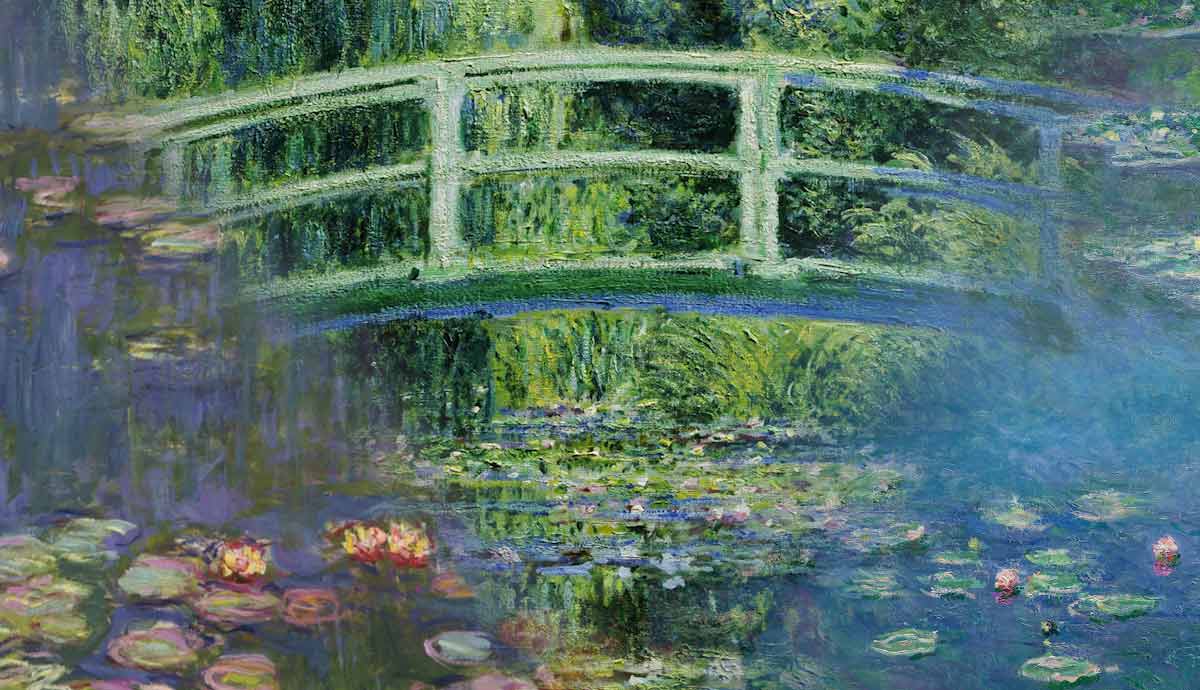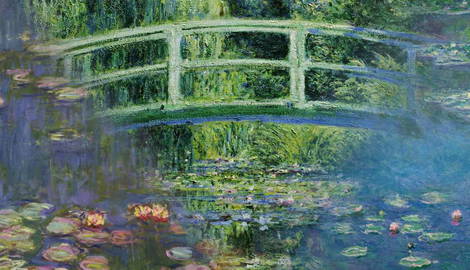
Claude Monet’s paintings have been the subject of fascination for millions. Thousands of artists, art historians, and art critics have studied his works in an attempt to unravel more details about his life, perspectives, and techniques. Monet dedicated 20 years of his life to making his Water Lilies series. It became the highlight of his artistic style and his Impressionist technique. Keep reading to discover more about the history, evolution, colors, and influences seen in Monet’s famous series.
Who Was Claude Monet?

Claude Monet is widely regarded as the pioneer of Impressionism. Without a doubt, he was one of the most consistent practitioners of this art movement. Interestingly enough, it was his painting, Impression, Sunrise, that inspired a critic to use the term Impressionism to describe the artists who displayed their work at the first Impressionist exhibition in 1874. At first, however, his artworks were seen as unfinished. Monet was not able to sell his pieces, so he struggled financially for a very long time. After the 8th Impressionist Exhibition of 1886 Monet and other painters finally received the recognition they deserved. Eventually, he paid off all his debts and he was finally able to envision a future without financial issues.

Anyone who has studied Monet’s art knows he was very passionate about gardening. Therefore, he took advantage of his good financial situation and bought a house with a garden in Giverny. He expanded the garden until it had a pond and a Japanese bridge, brought plants from all over the world, and hired several full-time gardens to take care of his project. This marked the beginning of his most famous series of paintings—Water Lilies.
Water Lilies Series: History and Evolution

Claude Monet started working on a project that would later become known as his Water Lilies series in 1899. He was already renowned for painting series of artworks like Haystacks and Rouen Cathedral. Water Lilies. However, the artist dedicated 20 years of his life to the Water Lilies, so the group consists of almost 300 paintings.

It is believed that Monet’s passion for Japanese ukiyo-e prints is the reason behind his idea of executing a series of paintings. Take Thirty-six Views of Mount Fuji by Hokusai, for example. They depict Mount Fuji from multiple points of view and during different seasons. Another notable series that may have influenced Monet’s Water Lilies is One Hundred Famous Views of Edo by Hiroshige which consists of 119 ukiyo-e prints.
The Evolution of Water Lilies’ Painting

The Water Lilies series is usually divided into two compositional groups: one that depicts the pond and vegetation, and the other one that portrays the water surface, the flowers, and reflections. At first, the paintings were executed on smaller canvases. In 1914, however, everything changed. Monet’s son, Jean, died, leaving the artist in a hopeless state. Although he had previously expressed his desire to paint water lilies on larger canvases, it was only after his son’s death that he materialized this idea. This great project yielded the large paintings that are now exhibited at the Musée de l’Orangerie.The biggest painting from the series, Water Lilies, The Two Willows, measures 55×6.5 feet.
Monet Worked on Water Lilies with Cataracts

Monet had trouble with his eyesight and he was diagnosed with cataracts. A German ophthalmologist recommended surgery, but Monet was too afraid to do it. So, he was prescribed glasses, which weren’t of too much help. If one were to analyze his works after 1914, one would notice how he started using darker colors and broader brush strokes. The famous Impressionist didn’t give up though—he started labeling his paint tubes and even wore a straw hat when he painted outside which was supposed to suppress glare.
Some art historians believe that the paintings he executed over the years he suffered from cataracts served as the bridge to abstract art. On the other hand, specialists aren’t entirely sure he changed his style on purpose. Once he underwent surgery and got his eyesight back, he returned to his style from before 1914.
Water: A Crucial Element in the Water Lilies Series

Monet’s painting River at Argenteuil signed in 1868 marks the beginning of his interest in depicting water on canvas. Only by studying his later works can we understand how much of an influence this element had on his style. The Water Lilies are by far the most iconic in this regard. The water element is quite important in this series, as most paintings do not feature anything else but water, water lilies, and the reflection of the surrounding garden. Nonetheless, he executed many other artworks that helped him explore the process of painting water and reflection.
Simulating the Sunlight Effect

Nonetheless, Monet’s Water Lilies would completely lose their magic without his masterful use of colors in transposing sunlight on canvas. Before the Impressionist era, painters mostly used blue, green, and yellow to paint landscapes. Monet and other Impressionists, however, decided that these three colors weren’t enough to simulate the sunlight effect. They realized they could use complementary colors to enhance and intensify the originally used shades.
What makes the Water Lilies series unique, though, is the way Monet chose to depict sunlight. In most of his Water Lilies artworks, we can only see the reflection of sunlight in water. So he took a huge step forward in his technique and chose to experiment with showing the passage of time and the playful nature of light only through the way it appears reflected in water.
Many paintings are cropped, and the horizon is cut from the view. By doing this, Monet changed the traditional composition—the brightest part of the artwork (the sky) wasn’t at the top of the canvas anymore. It could be anywhere, depending on what spot he chose to paint. Considering that the horizon line is regarded as a stabilizing element of a painting, the lack of it allowed viewers to explore the artwork without any spatial constraints.
Colors and Tools

Monet’s Water Lilies series was significantly influenced by the advances in technology and science. These include colors in tubes, paint boxes, and easels, which would become essential for the en plein air technique. While Monet took advantage of the wide array of colors in all his artworks, critics have been particularly interested in studying the pigments used in creating the Water Lilies paintings.
It seems he used much lead white in this series, a pigment obtained from exposing lead metal to vinegar and ingredients like animal manure. It was incorporated into almost all his paint mixtures. Lead white served for impasto, a painting technique that implies using visible brush strokes to apply a thick layer of paint, creating multiple layers.

Other pigments Monet used in his Water Lilies series include French ultramarine blue, a synthetic blue pigment extracted from a mineral called lapis lazuli. Although it had previously been highly expensive, by the time Monet started painting, the price of French ultramarine dropped significantly, so he used it extensively in his works. The artist often combined French ultramarine, a warmer color, with cobalt blue which ensured a cooler shade.
Monet also used viridian which consists of hydrated chromium oxide. It has a transparent green shade. It was either used as a standalone pigment or mixed with others. Monet often mixed it with yellow to depict the sunlight seen on the water lilies. Cobalt violets and red lakes were used as striking accents amidst bluish and greenish pigments.
All these colors were applied in layers. Monet worked on several paintings at the same time. He applied a layer of colors on one canvas and worked on a new one while the first dried out. Then, he returned to the first painting in order to apply another layer, thus creating a dynamic texture. However, sometimes, he was not patient enough to wait for the paint to dry so he added multiple layers on top of wet colors.
Where Can You See Monet’s Water Lilies?

By far the most famous home to some of Monet’s Water Lilies is the Musée de l’Orangerie in Paris. It features a display of the largest paintings in the series, which Monet started to work on in 1914. In 1918, a day after the Armistice of November 11, Monet expressed his wish to offer these paintings to the French State as a symbol of peace. Eight are now on display in the museum’s famous egg-shaped rooms.
Camille Lefevre and Georges Clemenceau played a significant role in designing the room and deciding on the position of the paintings. The panels had to be positioned in such a way as to create the illusion of an endless hole.
Other paintings from the Water Lilies series are scattered around the world. The works can be seen in museums like Princeton University Art Museum, Musée Marmottan Monet, Musée d’Orsay, Art Institute of Chicago, Metropolitan Museum of Art, Saint Louis Art Museum, and Pushkin Museum.
How Much Do Claude Monet’s Water Lilies Paintings Cost?

Based on the prices of some of Monet’s Water Lilies that were sold at auctions, we can conclude that, depending on the painting, their prices vary between $23 and $80 million. However, the most expensive painting, Water Lilies in Bloom (1914-1917) was sold in 2018 for $84.6 million. Another one, Water Lily Pond (1919), had been sold ten years before that for $80.5 million.
Monet’s paintings weren’t always as popular. His art gained momentum at the end of the 19th century. In the 20th century, however, Impressionism remained in the shadow of other art movements that conquered the public’s attention. When his large Water Lilies panels were displayed in 1927 at Musee de L’Orangerie, people didn’t even want to see them. The rooms were usually empty, and the staff sometimes even built temporary walls to cover Monet’s paintings so that they could exhibit other pieces there. During the 1950s people gained interest in Impressionism once again and Monet’s exhibition at L’Orangerie became the Sistine Chapel of Impressionism.










